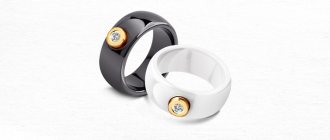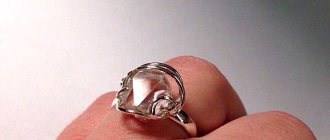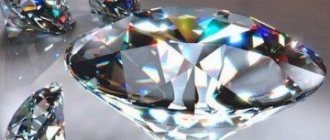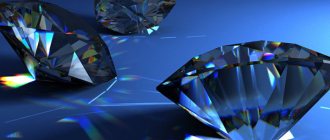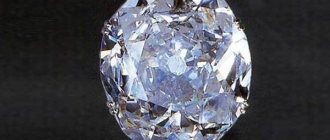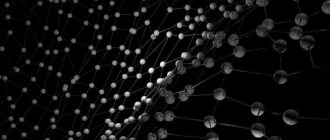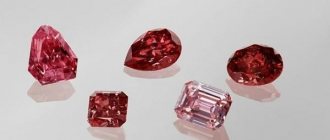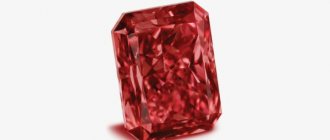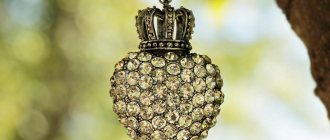507 carat Cullinan Heritage Diamond
Diamond
– the hardest mineral, cubic polymorphic (allotropic) modification of carbon (C), stable at high pressure. At atmospheric pressure and room temperature it is metastable, but can exist indefinitely without turning into graphite, which is stable under these conditions. In a vacuum or in an inert gas at elevated temperatures, it gradually turns into graphite.
- Structure
- Properties
- Morphology
- Origin
- Application
- Classification
- Physical properties
- Optical properties
- Crystallographic properties
See also:
Diamond
– price and medicinal, magical properties
Physical properties and structure of agate
STRUCTURE
Crystal structure of diamond
Diamond system is cubic, space group Fd3m. The elementary cell of the diamond crystal lattice is a face-centered cube, in which carbon atoms are located in four sectors arranged in a checkerboard pattern. Otherwise, the diamond structure can be represented as two cubic face-centered lattices, offset relative to each other along the main diagonal of the cube by a quarter of its length. A structure similar to diamond is found in silicon, a low-temperature modification of tin and some other simple substances. Diamond crystals always contain various defects in the crystal structure (point, linear defects, inclusions, subgrain boundaries, etc.). Such defects largely determine the physical properties of crystals.
Precious mineral deposit
In ancient times, diamonds were mined by hand from the ground or river sediments.
According to legend, birds were used to extract gems from deep crevices. To do this, they threw pieces of meat into the gorges, which the eagles hunted for. The stones stuck to the pieces, then people took them from the birds or looked for them in the droppings. In this way they managed to find even large nuggets .
Be sure to watch: Who is alexandrite suitable for: properties, compatibility and photo of the stone
In the mid-19th century, kimberlite pipes were discovered - these are pipe-shaped channels in the earth's crust that were formed during the breakthrough of magma. They are part of ancient volcanoes, the ground part of which has been destroyed. This depression is filled with igneous rock containing diamonds. According to experts, about 90% of all reserves of gems in nature contain kimberlite pipes. They got their name from the village of Kimberley (South Africa), where they first found such a crevice and crystals in it.
The main diamond mining centers are located in the Russian Federation (Sakha Republic), South Africa (Namibia, Botswana, Angola), Brazil (Minas Gerais, Bahia). You can also find gems in Australia, the USA, Canada, and Kazakhstan. Indian diamond mines are almost exhausted.
The world diamond market is led by the three largest in South Africa, ALROSA in the Russian Federation, and Rio Tinto Group in Brazil.
PROPERTIES
Diamond in the Rough
Diamond can be colorless, water-transparent or colored in various shades of yellow, brown, red, blue, green, black, gray. The color distribution is often uneven, patchy or zonal. Under the influence of X-rays, cathode and ultraviolet rays, most diamonds begin to glow (luminesce) in blue, green, pink and other colors. Characterized by exceptionally high light refraction. The refractive index (from 2.417 to 2.421) and strong dispersion (0.0574) determine the bright shine and multi-colored “play” of cut jewelry diamonds, called brilliants. The shine is strong, from diamond to greasy. Density 3.5 g/cm3. According to the Mohs scale, the relative hardness of diamond is 10, and the absolute hardness is 1000 times higher than the hardness of quartz and 150 times higher than that of corundum. It is the highest among all natural and artificial materials. At the same time, it is quite fragile and breaks easily. The fracture is conchoidal. Does not interact with acids and alkalis in the absence of oxidizing agents. In air, diamond burns at 850° C with the formation of CO2; in a vacuum at temperatures above 1,500 ° C it turns into graphite.
Who will benefit from diamonds and diamonds?
Graff yellow diamond necklace with 132 carat Golden Empress center diamond
Ring Tiffany & Co. with colorless diamonds and a blue diamond in the center
Diamond, like diamond, is the stone of the brave and determined. It requires a respectful attitude and may be useless in the hands of a weak, insecure person.
MORPHOLOGY
Diamond morphology is very diverse. It occurs both in the form of single crystals and in the form of polycrystalline intergrowths (“board”, “ballas”, “carbonado”). Diamonds from kimberlite deposits have only one common flat-faceted shape - the octahedron. At the same time, diamonds with characteristic curved shapes are common in all deposits - rhombic dodecahedroids (crystals similar to a rhombic dodecahedron, but with rounded edges), and cuboids (crystals with a curved shape). As experimental studies and the study of natural samples have shown, in most cases, dodecahedroid-shaped crystals arise as a result of the dissolution of diamonds by kimberlite melt. Cuboids are formed as a result of the specific fibrous growth of diamonds according to the normal growth mechanism.
Cullinan diamond broken into 9 parts
Synthetic crystals grown at high pressures and temperatures often have cube faces and this is one of their characteristic differences from natural crystals. When grown under metastable conditions, diamond easily crystallizes in the form of films and columnar aggregates. The sizes of the crystals vary from microscopic to very large, the mass of the largest diamond, “Cullinan”, found in 1905. in South Africa 3106 carats (0.621 kg). Several months were spent studying the huge diamond, and in 1908 it was split into 9 large pieces. Diamonds weighing more than 15 carats are rare, but diamonds weighing over a hundred carats are unique and are considered rarities. Such stones are very rare and often receive their own names, world fame and their special place in history.
Processing of diamond gems
We figured out what a diamond looks like in nature, but how does a diamond become a diamond? First of all, when it reaches the master’s table, the stone, or more precisely, a stone firmly welded to the rock, is x-rayed so that in the process of stripping the rock, knowing the size of the stone, the excess is not cut off. Although there are cases when it is more rational to split the stone into several small ones at the peeling stage. This is done in cases where one part of the stone is of great value, and it is simply profitable.
To cut a medium-sized diamond, use a diamond-coated saw, which is lubricated with oil during the cutting process. On average, one cut takes about four hours.
Next comes the grinding process. Depending on the initial size of the stone, the optimal shape of the future diamond with its inherent number of facets is selected. The process takes place on a CNC machine with 3D modeling. During this process, a securely fixed crystal is pressed against a cast iron disk, which removes absolutely all roughness. This process also lasts about four hours.
Over the next 3-4 hours, an experienced craftsman cuts the stone. The type of cut depends on the weight of the stone. Crystals weighing up to 0.03 carats receive 17 facets, from 0.03-1 carat - 33 facets. Anything larger than 1 carat is cut using the Tolkowsky method, with a result of 57 facets.
ORIGIN
Although diamond is metastable under normal conditions, due to the stability of its crystal structure, it can exist indefinitely without turning into a stable modification of carbon - graphite. Diamonds that are brought to the surface by kimberlites or lamproites crystallize in the mantle at a depth of 200 km. and more at a pressure of more than 4 GPa and a temperature of 1000 - 1300 ° C. In some deposits, there are also deeper diamonds brought from the transition zone or from the lower mantle. Along with this, they are carried to the Earth's surface as a result of explosive processes accompanying the formation of kimberlite pipes, 15-20% of which contain diamond.
Diamonds are also found in ultra-high pressure metamorphic complexes. They are associated with eclogites and deeply metamorphosed garnet gneisses. Small diamonds have been found in significant quantities in meteorites. They have a very ancient, pre-solar origin. They also form in large astroblemes - giant meteorite craters, where melted rocks contain significant amounts of fine-crystalline diamond. A well-known deposit of this type is the Popigai astrobleme in northern Siberia.
Diamonds
Diamonds are a rare, but at the same time quite widespread mineral. Industrial diamond deposits are known on all continents except Antarctica. Several types of diamond deposits are known. For several thousand years, diamonds have been mined from alluvial deposits. It was only towards the end of the 19th century, when diamond-bearing kimberlite pipes were first discovered, that it became clear that diamonds do not form in river sediments. In addition, diamonds were found in crustal rocks in associations of ultra-high pressure metamorphism, for example in the Kokchetav massif in Kazakhstan.
Both impact and metamorphic diamonds sometimes form very large deposits, with large reserves and high concentrations. But in these types of deposits, the diamonds are so small that they have no industrial value. Commercial diamond deposits are associated with kimberlite and lamproite pipes associated with ancient cratons. The main deposits of this type are known in Africa, Russia, Australia and Canada.
Fashion for raw stones
Today everyone strives to stand out with their individuality, to be different from everyone else. And where there is demand, there is supply. Relatively recently, jewelers began to include rough diamonds in jewelry, sometimes barely polished. Also, the fashion for such products comes from single craftsmen and jewelers who sell via the Internet based on a photo of a diamond, where they will cost a lot.
Of course, in order for such jewelry to look profitable and attractive, you must have subtle taste and choose the right materials and design for the stone. It is necessary to favorably emphasize the natural beauty, natural shape and magical glow inside the stone.
APPLICATION
Good crystals are cut and used in jewelry. About 15% of mined diamonds are considered jewelry, another 45% are considered near-jewelry, that is, inferior to jewelry in size, color or clarity. Currently, global diamond production is about 130 million carats per year. Diamond
(from the French brillant - brilliant), is a diamond that has been given a special shape through mechanical processing (cutting), a brilliant cut, which maximizes the optical properties of the stone such as brilliance and color dispersion.
Very small diamonds and fragments, unsuitable for cutting, are used as an abrasive for the manufacture of diamond tools necessary for processing hard materials and cutting the diamonds themselves. The cryptocrystalline variety of diamond, black or dark gray in color, forming dense or porous aggregates, is called Carbonado
, has a higher abrasion resistance than diamond crystals and is therefore especially valued in industry.
Small crystals are also grown artificially in large quantities. Synthetic diamonds are obtained from various carbon-containing substances, mainly from graphite, in special. apparatuses at 1200-1600°C and pressures of 4.5-8.0 GPa in the presence of Fe, Co, Cr, Mn or their alloys. They are suitable for technical use only.
Diamond – C
| Molecular weight | 12.01 g/mol |
| origin of name | From Greek, adamas, meaning “invincible” or “solid.” |
| IMA status | valid, first described before 1959 (before IMA) |
History of the discovery of diamond
Rough diamonds.
Photo: annamoltkehuitfeldt.wordpress.com The exact time of the discovery of the diamond has not yet been established. The thing is that the appearance of unprocessed minerals is quite trivial and does not attract much attention. The first mentions of Indian stones date back to the 3rd millennium BC, but they began to be used in jewelry only about 500 years ago, after craftsmen mastered diamond cutting methods. Advertising - Continued below
In Russia, Catherine II had a special love for them; during her reign, the concept of a diamond came into use as a synonym for wealth and luxury.
The name of the mineral in different languages has a similar sound and meaning. The Arabs called it “almas”, that is, “the hardest”, the Greeks called it “adamas”, which means “indestructible”. The Russian word “diamond” was introduced into circulation in the middle of the 15th century by the traveler Afanasy Nikitin in the book “Walking across Three Seas.”
PHYSICAL PROPERTIES
| Mineral color | colorless, yellowish-brown fading to yellow, brown, black, blue, green or red, pink, cognac brown, blue, lilac (very rare) |
| Stroke color | no |
| Transparency | transparent, translucent, opaque |
| Shine | diamond, bold |
| Cleavage | octahedron perfect |
| Hardness (Mohs scale) | 10 |
| Kink | uneven |
| Strength | fragile |
| Density (measured) | 3.5 – 3.53 g/cm3 |
| Radioactivity (GRapi) | 0 |
| Thermal properties | High thermal conductivity. It feels cold to the touch, which is why diamond is called “ice” in slang. |
Kinds
The most famous is the classification of diamonds by color:
- yellow - approximately 0.05% of nitrogen atoms replace carbon elements in the lattice. Dark yellow crystals are especially valuable. Shades range from light yellow to dark brown;
- blue – contains an admixture of boron;
- blue - also contains a small amount of boron atoms. These are very rare and expensive specimens;
- green – the presence of sulfide impurities in the composition;
- red – contains chromium atoms. This is the rarest type of diamond;
- pink – there are no foreign atoms in the crystal lattice. The reasons for the appearance of this shade are unknown;
- white – contains only carbon atoms. A pure white diamond is rare.
Pure black diamonds are extremely rare, contain few inclusions, are translucent and are expensive. Their color is explained by the presence of graphite, magnetite and hematite.
In addition, there are the following types of diamonds:
- A diamond is a gem obtained after processing, which has 57 facets, its brilliance is dazzling.
- A bead is a granular formation of irregular shape.
- Ballas is a spherical crystal that has a radial-radiant structure.
- Carbonado is a fine-grained, porous aggregate of a gray, greenish or black hue.
There are also dark-colored diamonds called “Yakutite”, which contain many inclusions and are extremely hard.
Would you like to find a diamond nugget?
Not really
OPTICAL PROPERTIES
| Type | isotropic |
| Refractive indices | nα = 2.418 |
| Maximum birefringence | δ = 2.418 – isotropic, does not have birefringence |
| Optical relief | moderate |
| Optical axis dispersion | strong |
| Pleochroism | does not pleochroate |
| Luminescence in ultraviolet radiation | sometimes blue or phosphorescent |
How to distinguish a diamond from a fake at home
You can determine the authenticity of a diamond using several techniques:
- move the stone along the glass with pressure - a real diamond will leave a deep scratch;
- grease the surface of the stone - a wide strip will remain on the real one, and droplets will form on the fake;
- shine an ultraviolet flashlight on it - the real one will begin to shimmer in different colors;
- shine a ray of light on the stone - it will pass through unchanged.
Reliable determination of authenticity is carried out using complex chemical reactions in special laboratories. The artificially grown stone most similar to diamond is cubic zirconia (see differences between cubic zirconia and diamond).
A little about mining
Diamonds are mined in Russia, Congo, South Africa, and Namibia. There are small deposits in Canada, Australia, Angola, and Botswana. Diamond mining is an expensive and labor-intensive process. Until the middle of the last century, the place to search for gems was mainly secondary deposits, the formation of which occurred as a result of the destruction of rocks. The process looked like gold mining: sand from the river was placed in a sieve using shovels and sifted, and then washed.
The largest reserves of future diamonds lie in primary rocks called “kimberlite pipes.”
Preparation for production is carried out in two stages:
- Formation of a 600-meter deepening using explosives.
- Laying mines.
Ore mined from the depths of the earth is delivered to factories for grinding and washing. To obtain one carat of crystals, sometimes it is necessary to process up to hundreds of tons of rock. Then culling takes place to select a certain type of diamond using water and X-rays, after which the stones are handed over to the cutters.
Medicinal qualities
Diamond is valued for its energy potential. Its vibrating waves radiate only positive qualities. That is why they can solve many health problems:
Relieve inflammatory processes and treat diseases of the skin, bronchi, bladder, gastric system and liver.- Promote the normal functioning of the nervous system, eliminate symptoms of irritation, insomnia, and even in the treatment of schizophrenia it is possible to achieve positive changes.
- Normalize the functioning of the cardiovascular system, improving rhythm and pressure.
- Increase the chance of getting pregnant, and the passage of this stage occurs in a normal state.
There is one very unusual remedy - “diamond water”. This elixir is very easy to prepare. The mineral is placed in water for a day, and the liquid is charged with all the energy and healing properties. After this, you can use the prepared product internally. It helps to quickly recover from operations and complex illnesses.
Well, people who are impulsive and have high blood pressure are not recommended to constantly carry a diamond with them.
Is there anything harder in nature?
The hardness of diamond stone has long been known, and it is believed that it has no equal in this regard. However, curious humanity has long been asking the question: maybe there is some kind of rock or other minerals in nature that could compete with a diamond in terms of its legendary “indestructibility”?
I would like to immediately assure everyone who is interested: diamond is the hardest mineral, and there really is no equal to it in this area. It fully lives up to its name, and only it itself can become harder if it is processed using a special method.
What determines the hardness for which diamond stones are so famous? This indicator directly depends on the composition of their crystal lattice. If the crystal lattice is processed using a certain method, removing all possible defects from it, then it is possible to obtain a new laboratory substance called “hyperdiamond” synthetically. This is a diamond whose crystal is so perfect that its strength is eleven times that of natural material. The basis was the type of durable “lattice” that was given to scientists by a rare variety of diamond called “carbonado”: a black stone. About the black diamond →
As you know, ordinary single-crystal (or single-crystal) diamonds are imperfect and have many natural flaws and cracks. It happens that they cannot withstand very high temperatures and pressure. But after specialists were able to reproduce the polycrystalline structure of carbonado in laboratory conditions, we can say with confidence that there is definitely no stone harder than such a material. It can be used to create products of a wide variety of sizes and shapes, which are extremely resistant to any temperature conditions.
